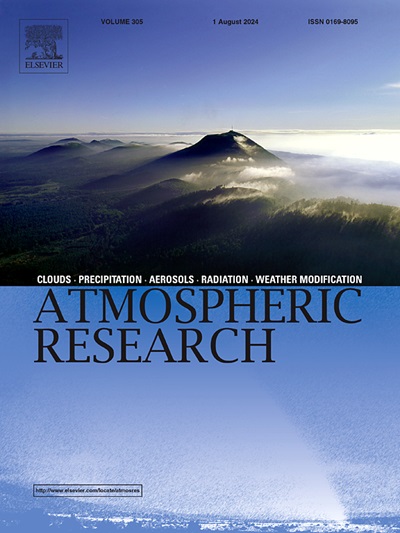阿拉伯半岛上空再分析与观测数据之间的 2 米地表温度数据比较
IF 4.4
2区 地球科学
Q1 METEOROLOGY & ATMOSPHERIC SCIENCES
引用次数: 0
摘要
2 米气温数据是研究极端天气以及地表与大气之间水和能量通量交换的重要指标。本研究利用各种统计误差指标和阿拉伯半岛(AP)地区的极端温度指数,比较了三个再分析数据集(即ERA5、ERA5-Land 和 MERRA-2)与 1990 年至 2022 年的原地观测数据。我们之所以选择这些再分析数据集,是因为这些数据集不断改进,时空输出更高,能更好地捕捉温度变化。时空气候学显示冬季气温较低(15 °C),夏季气温最高(35 °C);然而,再分析数据显示冷季气温偏差大于暖季。再分析数据低估了四个地区的低温日(10 °C)和高温日(30 °C)的频率,只有ERA5-陆地数据与观测数据密切相关。从相关性的强度来看,极端寒冷天气(寒冷夜晚和寒冷白天)频率的相关性(>0.90)优于极端炎热天气。在年际尺度上,再分析产品与大部分地区的实地数据表现出很强的相关性(0.90),尤其是在冬季和秋季,春季的相关性一般,夏季的相关性较弱。再分析数据在内陆地区呈现负偏差,在沿海地区呈现正偏差,时空均方根差(RMSD)一致。性能差异是由于地形和能量通量表示不佳造成的,特别是在 MERRA-2 中,以及观测数据的缺失。本研究建议将ERA5-Land作为该地区极端天气模拟的首选,其次是相同尺度的MERRA-2和ERA5,但在使用再分析数据进行冷热极端天气模拟时需要适当注意。本文章由计算机程序翻译,如有差异,请以英文原文为准。
Comparison of 2-m surface temperature data between reanalysis and observations over the Arabian Peninsula
The 2-m temperature data is a significant indicator for studying the weather extremes and the exchange of water and energy fluxes between the surface and atmosphere. This study compared three reanalysis datasets, i.e., ERA5, ERA5-Land, and MERRA-2, with observations from in-situ sources from 1990 to 2022 using various statistical error metrics and extreme temperature indices over the Arabian Peninsula (AP) region. We selected these reanalysis datasets due to the continuous improvements and higher spatiotemporal output better capturing the temperature variability. The spatiotemporal climatology shows lower temperatures in winter (<15 °C) and maximum in summer (>35 °C); however, the reanalysis data show more deviations in temperature during the cold season than in the warm season. The reanalysis data underestimated the frequency of the cold (<10 °C) and hot (>30 °C) days across the four regions, except ERA5-Land, which closely followed observed data. The strength of the correlation shows better performance (>0.90) in the cold extremes (cold nights and cold days) frequency than the hot extremes. On an interannual scale, reanalysis products exhibit strong correlations (>0.90) with in-situ data across most regions, particularly in winter and autumn, moderate in spring, and weaker in summer. The reanalysis data shows negative biases in the inland regions and positive biases in the coastal areas with consistent root mean square differences (RMSD) spatiotemporally. The differences in performance are due to the topography and poor representation of the energy fluxes, especially in MERRA-2 as well as missing data in observations. This study recommends ERA5-Land as the first choice for extreme weather simulations in the region, followed by MERRA-2 and ERA5 on the same scale, but proper attention is needed when using reanalysis data for cold and hot extremes.
求助全文
通过发布文献求助,成功后即可免费获取论文全文。
去求助
来源期刊

Atmospheric Research
地学-气象与大气科学
CiteScore
9.40
自引率
10.90%
发文量
460
审稿时长
47 days
期刊介绍:
The journal publishes scientific papers (research papers, review articles, letters and notes) dealing with the part of the atmosphere where meteorological events occur. Attention is given to all processes extending from the earth surface to the tropopause, but special emphasis continues to be devoted to the physics of clouds, mesoscale meteorology and air pollution, i.e. atmospheric aerosols; microphysical processes; cloud dynamics and thermodynamics; numerical simulation, climatology, climate change and weather modification.
 求助内容:
求助内容: 应助结果提醒方式:
应助结果提醒方式:


